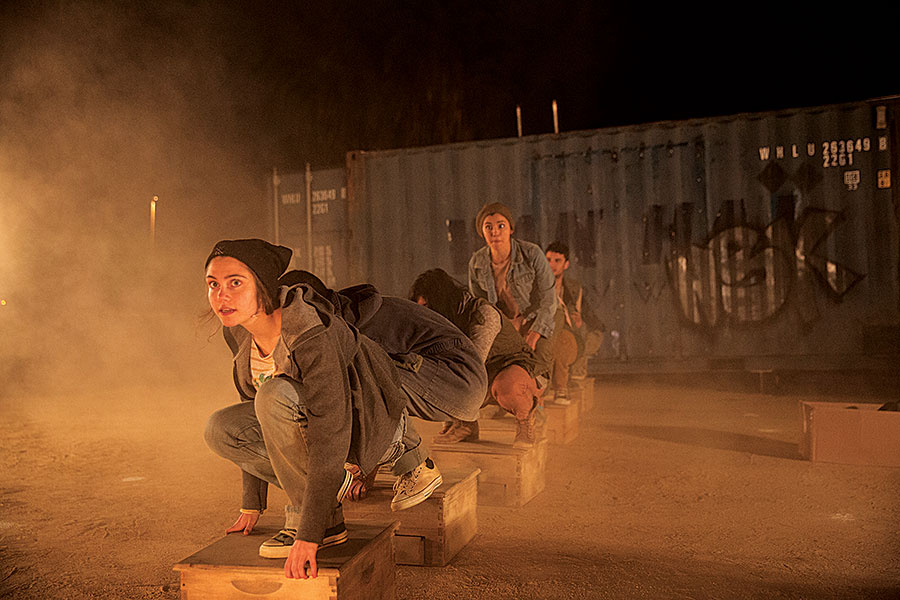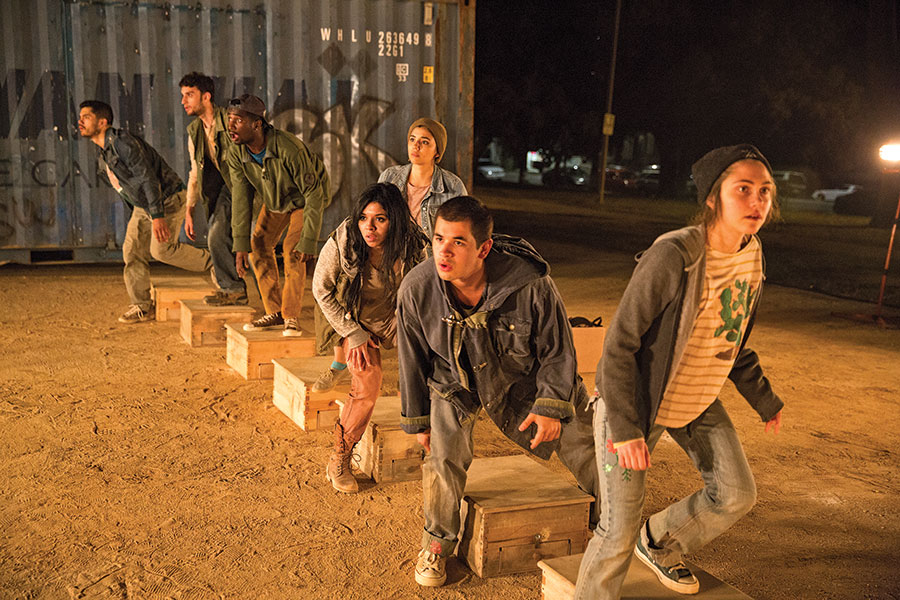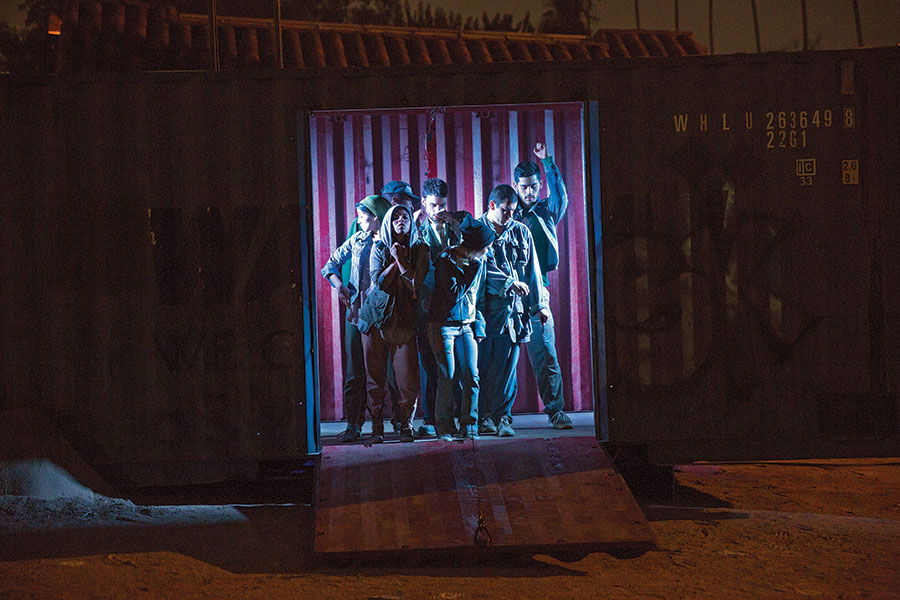As he sings the mournful melody “Ya me boy a morir a los desiertos” (“I am going to die in the desert”), actor Andres Velez stands not on a podium but inside a cardboard box. There are plenty to choose from: Boxes and containers play key functions and are the dominant props of Efren Delgadillo Jr.’s set for the play Shelter. The most practical of props, not only does a cardboard box transport easily, it can be used to hold pretty much anything: clothes, books, files, discarded traces of human lives.
Even dreams. Marissa Chibas’s script specifies that Shelter’s boxes contain “things they are carrying with them on the journey,” but the audience never sees them opened. In an early scene, the play’s seven company members jump with surprise as the boxes they are holding leap forward, popcorn-like, as though some live being—their jittery imaginations, perhaps—were trying to burst out.
In Shelter, Chibas investigates a less publicized element of the U.S. immigration crisis: the one caused by the flood of undocumented and unaccompanied children from Central America who cross the U.S./Mexico border each year by the tens of thousands. Produced by the Center for New Performance at California Institute of the Arts (CalArts) and performed in English and Spanish, Shelter played an eight-performance run outdoors in April in East Los Angeles’s Lincoln Park.
In the winter of 2014, she first became aware of the plight of young Central American refugees after reading an article in Los Angeles Times. More than two years later, with multiple workshops, conversations, and a first production of Shelter under her belt—it will have a future life in other venues—Chibas now talks about producing a theatrical cycle around the issue of migration.
The project sits squarely at the crossroads of arts and activism that university officials say is a critical part of the CalArts mission. Chibas, who heads the bilingual initiative Duende CalArts, partnered with immigrant rights organizations, think tanks, city agencies, and schools. She interviewed teenagers who had made the journey and later brought them to workshops to play theatre games and interact with the student performers who would enact their stories.
Taking as much creativity and producerial legwork as making the play itself have been the community tie-in activities for Shelter. Chibas and director Martin Acosta, artistic director of Mexico’s Teatro de Arena, organized discussion panels and school workshops, and even canvassed neighborhood businesses to stimulate awareness and audiences. Cast members from the all-student production have rotated in and out for various workshops and readings, all of which included post-show discussions and talkbacks.
“I was very active with the 52nd Street Project in New York,” Chibas recalls, referring to an organization that makes theatre with underserved city students. She has continued that ethos with Duende CalArts, which “very much combines my interests as a theatre artist and the work that I do in the community with kids, and finding ways to overlap and integrate them.”

In most news reports and policy discussions about immigration that have dominated this year’s election cycle, immigrant children have taken on labels—refugees, asylum seekers, child migrants, “undocumenteds,” and worse—but they rarely acquire distinct names or faces. That’s something Chibas set out to correct with Shelter, in which we meet Eusibio from Honduras, age 13, who says, “I want to be a businessman—a rich one”; 14-year-old Poncho from Guatemala, an aspiring doctor who also raps “to keep my patients happy”; Maria from El Salvador, who wants to construct buildings that withstand earthquakes. We meet them huddled in the desert, awaiting the arrival of an unnamed “coyote” who has taken money and promised to smuggle them to freedom. As they wait, the kids talk about their potential savior in terms that Godot himself would envy: survivor, undefeatable, brutal, lion.
Savior or not, the kids themselves will need that kind of strength. In the play, a human-rights activist notes that 40 percent of minors who flee the violence of their home countries for safety and greater opportunities in the U.S. will die on the journey. Those who arrive safely encounter a new homeland that is unwelcoming, where they will face everything from bureaucratic processing by federal agencies to placement in temporary shelters, even potential deportation.
“The truth is simpler than what we make it,” says Peter Mark, a second-year MFA from Brazil who portrays a 15-year-old Honduran, Julian. “The kid I’m playing is talking about his dream and he says, ‘I want to have open space and I want to ride a motorcycle.’ That’s totally fair.” He remembers Acosta, the director, telling him during rehearsal, “Don’t get poetic with it. It’s not poetry. It’s a simple desire.”
Eusibio, Poncho, and their fellow dreamers certainly have a sense of the danger they’re facing, but statistics are meaningless to them. The odds are against them, in other words—but isn’t one of the universal characteristics of impetuous youth to disregard the odds?
“Children are telling this story, and there’s no tragedy for them,” says Acosta. “There’s only a great adventure, and for that I need bodies moving faster than they do usually and doing strange or weird things that they wouldn’t usually do.”
Speaking from a conference room on the Valencia campus of CalArts in late March, Acosta talks about journeys, both real and theatrical. The opening of the play’s “site-responsive” run in Lincoln Park is 10 days away, and, at the conclusion of the interview, the director moves outside to a lawn near the campus entrance where he will rehearse his company—seven actors, three understudies—in the shadow of the biggest “box” of all: a 20-foot metal shipping container that has been graffitied up. It squats on the ground like a cross between a dilapidated freight car and an oversized industrial trash bin, and the entire set fits inside the container, which can then be towed from location to location.
One of Shelter’s most vivid sequences takes place on the cargo train known as La Bestia (“The Beast”), which immigrants board to cross Mexico toward the U.S. border. Sitting atop the container, a journalist interviews a human-rights activist who talks about the dangers the kids face in their home countries and the risks they take trying to take the beast to freedom. Riders are frequently gouged, lose limbs, or are knocked off La Bestia by tree branches. Others are kidnapped or attacked by members of the Mexican mafia. Choreographer Fernando Belo stages these scenes via wordless vignettes, which are accompanied by wailing and the eerie clicking sound of the train as riders fall to their deaths.
That container makes for an imposing “beast,” indeed. But though it’s central to his staging, it is not necessarily Acosta’s favorite item.
“We have a container to have the reality there,” says Acosta. “I prefer theatre, so I prefer to use the container in a different way—like something magical. It sounds pretentious, but a container is boring. I can see it only for a few minutes, and then it’s too much. But what happens if we have an angle in it: something weird floating on one side or sinking on the other side?”

Magic and realism sit side by side in this endeavor. After interviewing several recent arrivals, Chibas blended their stories with folklore, dramatic vignettes, news accounts, and testimony from sociologists, editorial writers, and politicians. The statistics are grim and the number of casualties appalling, driving author and activist Sonia Nazario to conclude a 2014 New York Times editorial, “The Children of the Drug Wars: A Refugee Crisis, Not an Immigration Crisis,” with the observation/admonition: “This is not how a great nation treats children.”
Chibas hopes that Shelter will illuminate their stories and advance the larger conversation. The daughter of a Cuban refugee who steeped in the legacy of El Teatro Campesino, Chibas meshes well with Acosta, whose oft-repeated mantra is, “I do not know how to do politics, and I do not know what directions need to be taken—I know how to do theatre.”
As personal as she was determined to make Shelter, though, Chibas discerned that the play needed documentary-like data as well. The same actors who play the kids wear business suits for Shelter’s second chapter, “People Circling Around the Crisis…From Above.” Blending sentiments that are equal parts self-righteous and outwardly concerned, the talking heads toss out sound-bite opinions: Parents should do more to give their kids opportunities; by encouraging amnesty, President Obama brought on this crisis; the U.S.’s illegal drug market has exacerbated the crisis; the U.S. can barely take care of its own impoverished, let alone take on the burden of other nations.
“Why are all the world’s problems our problem?” one asks. “Why, why, why is it always our problem?”
“Once I saw the commentary in The New York Times, I realized that had to be included in some way,” Chibas says. “I thought those voices, the different opinions on the crisis, were important to hear. It’s like we’re getting glimpses of the crisis in order to get ultimately a bigger picture.”
In her research, Chibas read “Enrique’s Journey,” Nazario’s Pulitzer-winning account of a Honduran boy traveling to the States to find his mother. In addition to visiting a shelter in San Diego, the playwright approached David Levine, an instructor at the School of History and Dramatic Arts (SoHDA), a downtown-area high school that collaborates frequently with CalArts through the university’s Community Arts Partnership. Levine had noticed an increase in the number of new SoHDA students from Central America, and he introduced Chibas to several recent arrivals. Over the course of his class’s personal-narrative unit, Levine’s students heard many of these stories, several of which later became the inspiration for Chibas’s Shelter kids.
“One of the stories had the entire class in tears, just shell shocked,” recalls Levine. “I have a daughter who is in her first year of college. I can’t imagine her, at 14, going through something like that.”
One of Levine’s students, Jasmine, fled El Salvador after being pressured to join a gang. Her mother and two sisters remained behind. During her time in the United States, Jasmine has discovered a love of theatre (“My teacher always says, ‘Jasmine, you’re so dramatic’”), and thinks she might someday go into acting—or maybe engineering. As she watched a workshop of Shelter, Jasmine says that Chibas and the Shelter actors nailed the experience. Details like the kids carrying bits of their home life on the journey have resonance, says Jasmine, whose story was one of the primary sources of the play.
“What I went through, a lot of other people went through as well,” she says through an interpreter. “I feel like through this play, we can express things that people don’t usually talk about.”
The Shelter company is comprised of current CalArts students or recent graduates. Among them is Moriah Martel, who attended an early meeting of Duende CalArts during the second year of her BFA program. When she heard Chibas talk about a dramatic project investigating immigration, Martel offered her services as a research assistant.
“We’re always trying to come from an informed place,” Martel says. “I think that’s one of the main ideas of the project. If we know what we’re talking about, we’re giving more info to the audience.”
After Martel had spent several months compiling everything from Salvadoran folk tales to ghost stories to National Public Radio interviews, Acosta told Chibas that Martel needed to be part of the acting company. Chibas agreed.
“They all have tremendous energy and they’re all very disciplined, dedicated performers,” says Chibas of the ensemble. “That’s a real requirement of this piece. I watched them do their little group warmup where they do this synchronized jumping in space. From last year to now, it’s 360 degrees difference. They’re really one unit breathing together, working together, even though they’re bringing new people in and out.”
Shelter’s first performance was at the Los Angeles Central American immigrant-rights organization, CARECEN, where performances regularly incorporated time for the post-show talkbacks. Producers have also built a version of the play that can travel to schools and community centers. Shelter’s journey—like those of its subjects—is far from over, say university officials, who expect the production to enjoy a life well past its spring engagements (including one at TCG’s Global Pre-Conference in Washington, D.C., in late June). According to Travis Preston, dean of the CalArts School of Theater and artistic director of the CalArts Center for New Performance (and Chibas’s husband), CalArts has been approached by theatres in Texas and Minnesota.
“We’re very excited about how Shelter is speaking to multiple communities about an issue that we feel is absolutely essential and extremely timely,” says Preston.
Timely is right: At a post-show talkback, one appreciative audience member offered a provocative suggestion.
“You should perform this,” he says, “in front of Trump Tower.”
Writer, editor, and blogger Evan Henerson is based in Los Angeles.


